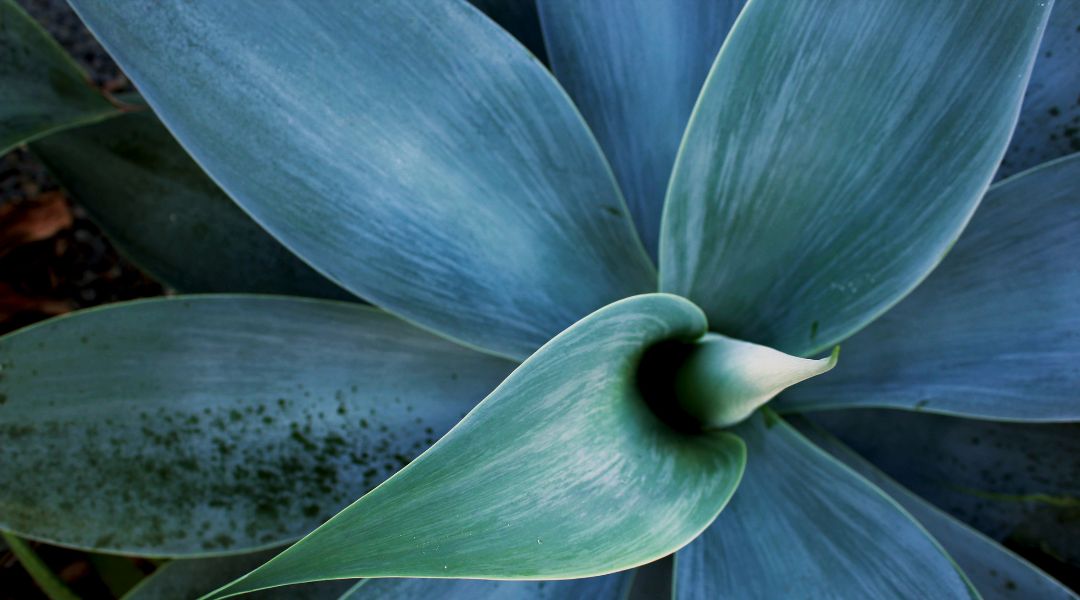- Adding the color blue to your garden can reduce stress by encouraging a sense of calm.
- Weaving blue plants throughout your garden is a great way to create a feel of continuity.
- Planting blue succulents can simply add interest and beauty to your garden (or even a small pot by your window).
There are lots of ways to add blue to your garden, including succulents and other types of plants. There’s the stunning blue of Blue Ice Yellow-wood (Podocarpus elongatus ‘Icee Blue’ (‘Monmal’)), for example. Or the beautiful blue flowers of some salvia, agapanthus, and hydrangea. There’s also the beautiful blue of the five easy-to-grow, drought tolerant succulents I’m covering in this post. Enough build up — let’s get to it!
5 Blue Succulents for Your Garden
1. Echeveria ‘Arctic Ice’
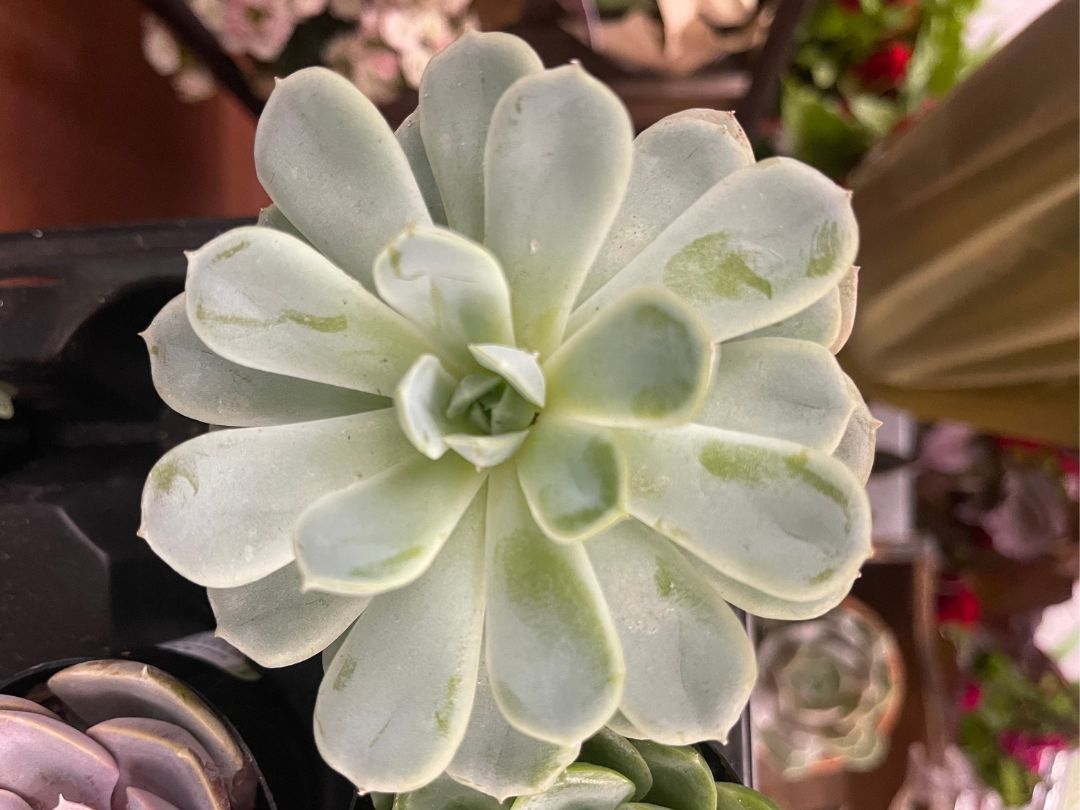
To kick off our exploration of blue succulents, let’s start with an echeveria. There are a bunch of beautiful blue echeveria, and I’ve blogged about these easy to grow succulents before. In this post, I’ve narrowed my focus to one variety of blue-green echeveria, for when you want that dash of a cool color in your garden or container. And, I do mean dash!
Echeveria ‘Arctic Ice’ is a small succulent. (What a great name, by the way — how much cooler can you get than arctic ice?) It’s hard not to love these charming little succulents with their smooth, icy blue-green leaves and tidy compact rosette form. The blue rosette only gets to about 4” in height and 8” in width.
While the name of the plant may have ice in it, this succulent likes it sunny. Echeveria needs bright sunlight to maintain its color and form. The leaves have a coat of farina on them, which is a powdery wax. This wax protects the plant from the hot sun and gives the plant a soft pastel look.
Echeveria ‘Arctic Ice’ likes its soil well-draining and not a lot of water. You will want the soil of this plant to dry out between watering.
Echeveria is usually kind enough to produce offsets, or chicks, at the base of the plant. These chicks can be removed and transplanted. You can also propagate echeveria from stem cuttings or from mature leaves.
Can’t find Echeveria “Arctic Ice”? There are many other blue echeverias. ‘Arctic Ice’ looks very much like Echeveria tolucensis, which looks very much like Echeveria secunda. Other blue echeveria to check out are Echeveria elegans, Echeveria abalone, Echeveria Lara, Echeveria Lola, Echeveria Minima, Echeveria Blue Heron, Echeveria colorata, Echeveria giggaflora . . . I think you get the idea. Let’s move on!
2. Dudleya brittonii
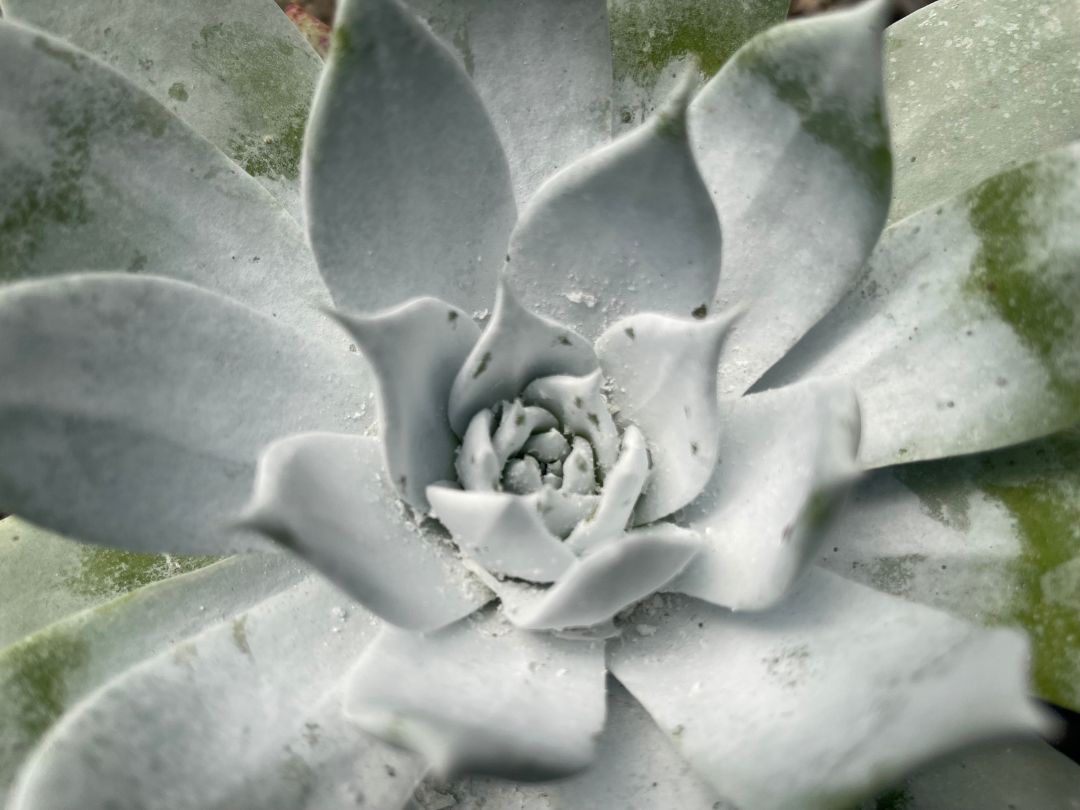
Dudleya brittonii is known as Giant Chalk Dudleya. This is an eye-catching grey-blue rosette-shaped succulent. These guys are commonly referred to as “liveforevers.” Why, you ask? It’s because they can live a long, long time — as long as 50 or even 100 years.
These blue succulents are native to southwestern United States. Karen (my blog partner) and I are lucky because we happen to live in this part of the world and many Dudleya are native to our region, like Dudleya lanceolata (Lance-Leaved Dudleya), Dudleya pulverulenta (Chalk Dudleya), and Dudleya Brittonii (Britton’s Dudleya/Giant Chalk Dudleya). I have chosen this particular Dudleya for its beautiful blue appearance and its relative ease of sourcing. This Dudleya is probably the most popular in cultivation.
I never thought I would need to write this, but be careful where you source your Dudleya! There are actually poachers out there that dig this plant up in its native habitat and sell it. Plant smugglers are endangering this beautiful blue succulent. There is a bill that makes it “unlawful to steal and sell Dudleya taken from state, local, or private lands, and establishes strong penalties for violations.”
Let’s talk about one of this plant’s common names: Giant Chalk Dudleya. These plants have a powdery, or chalk-like, appearance due to a waxy layer called farina. Like with the blue echeveria, this layer creates a natural protection from excessive sun exposure or bad weather as well as a luminous appearance. The waxy layer can get so thick on this succulent that you can actually scrape off this layer when you scratch the leaves — which you don’t want to do. You want the plant to keep this natural sun protection.
Because of its size, there’s an added word of Giant to this common name. This blue succulent gets larger than your average echeveria rosette. Chalk Dudleya gets to 12-18” tall and wide.
The flower of Giant Chalk Dudleya is tall, with a vibrant red stalk and yellow flowers. It blooms in the spring and summer, attracting hummingbirds and pollinators.
These particular blue succulents like well drained soil — and some inland shade if it’s going to be hot and sunny. I’ve had some trouble incorporating this plant into some gardens due to irrigation. It doesn’t like to be doused by sprinklers in the summer.
3. Aloe ‘Blue Elf’
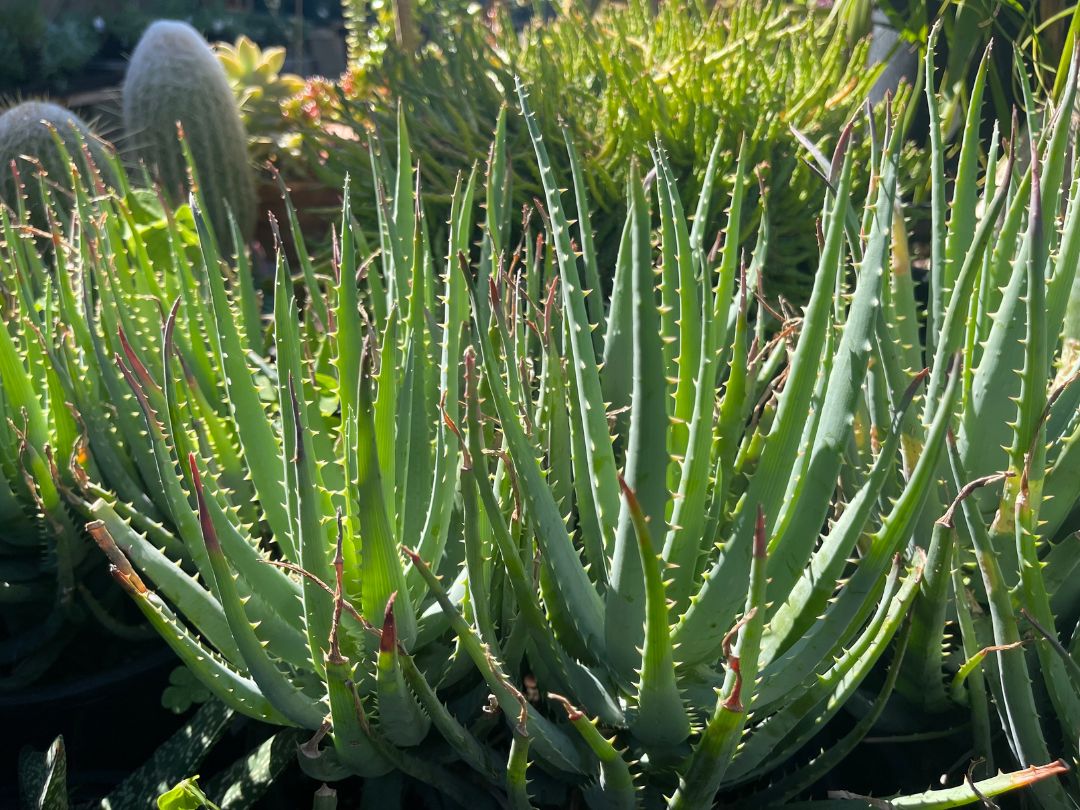
Aloe ‘Blue Elf’ is a popular tight-clumping succulent that forms rosettes of upright gray-blue leaves with teeth along the margins. It grows up to 18″ tall and 2′ wide. While usually more blue, the leaves will turn pinkish-red when stressed.
This is an easy-to-grow small upright aloe, which has the added benefit of producing a beautiful flower. The tubular, orange flowers appear on showy spikes, usually from early winter to early spring.
Aloe ‘Blue Elf’ succulents can handle poor soil, and are perfect for rock gardens and containers.
This hybrid is also sold as Aloe ‘California Aloe’ (not Aloe ‘California’, a similar but more robust plant) or Aloe ‘Blue Boy’ (not to be confused with another hybrid with the same name). But really, how can that NOT be confusing?
3. Senecio mandraliscae
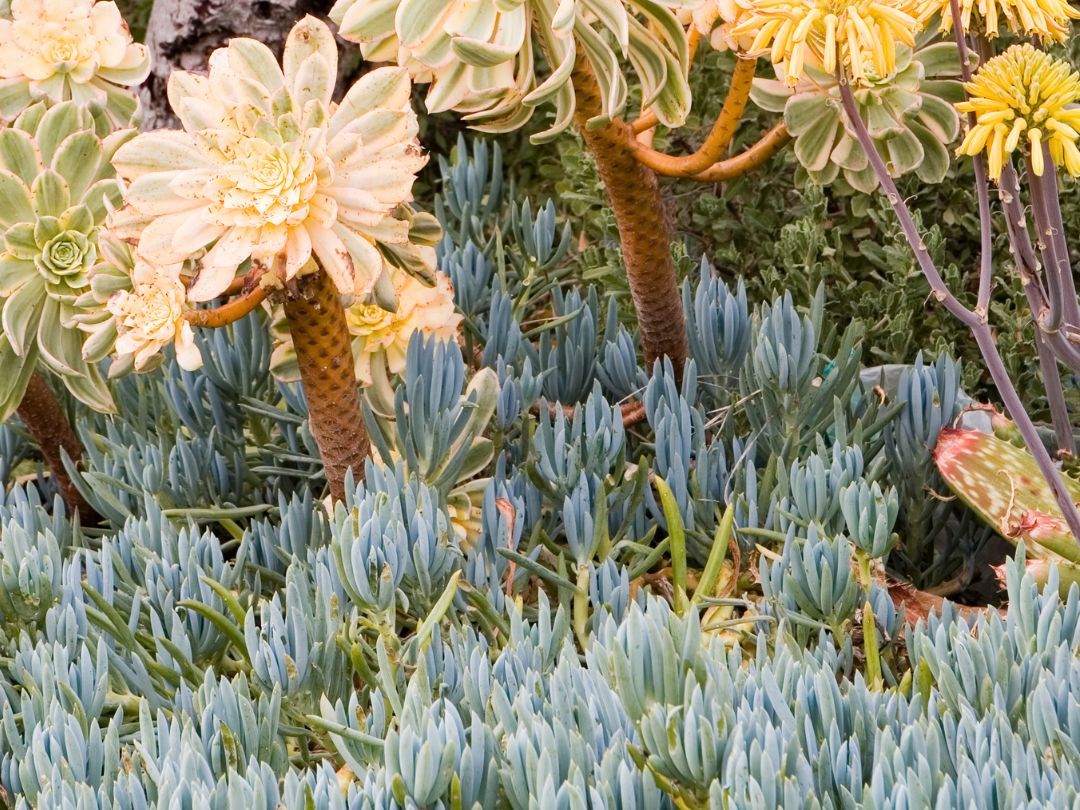
This plant is also referred to as Blue Chalksticks, Blue Senecio, Kleinia mandraliscae, Senecio talinoides var. mandraliscae, Curio talinoides var. mandraliscae, and Kleinia comptonii. It’s sometimes hard to imagine how much more confusing it can get. We’ll keep it simple and use the common name I know it as: Blue Chalksticks.
I have used this plant constantly over the years. Even my blog partner has some in her yard. It is a very unique drought tolerant, and easy-to-maintain blue-green succulent.
This succulent grows 1-3’ tall and 2-3′ wide. You can buy this plant by the flat, which is about 36 of them for about $30. Think about that: One flat could create a sea of blue-green color, covering about 300 square feet. I’m not sure if you necessarily want this much senecio in even a large garden, but it is nice to know you can get this coverage.
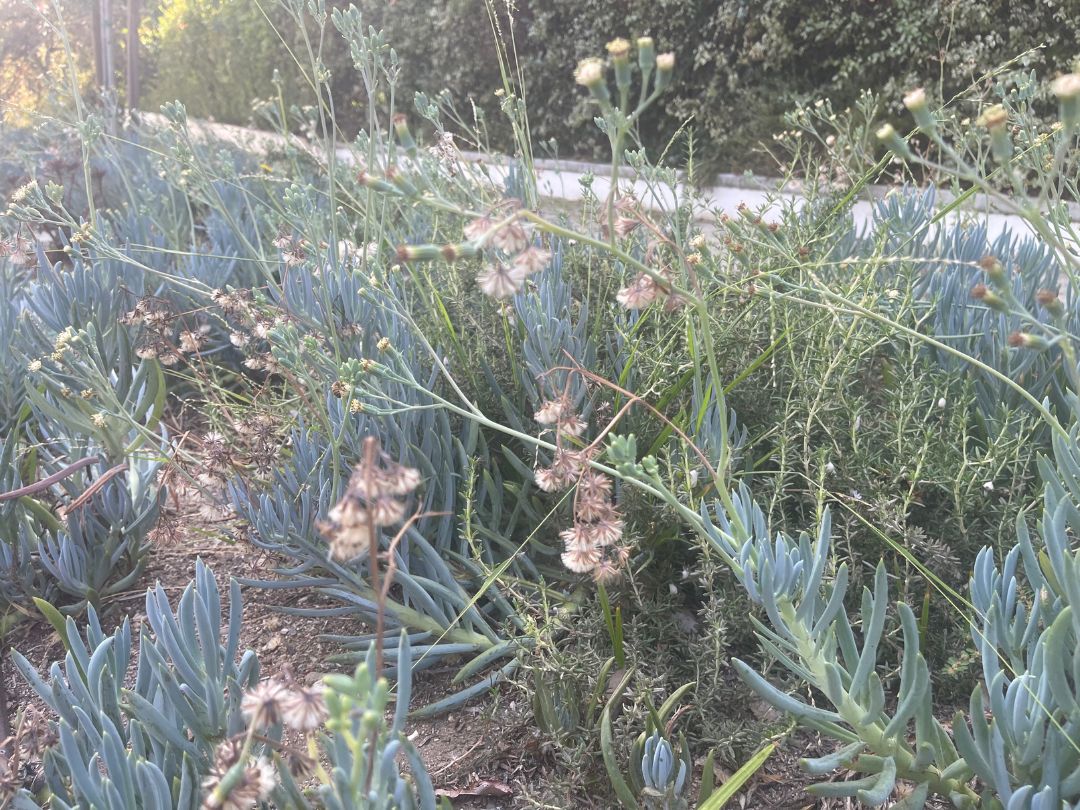
One thing I need to add is that I’m not in love with its flowers! Senecio mandraliscae has small daisy-like flowers with dandelion-like seed puffs which don’t add to the beauty of the plant. Don’t let this deter you from using this wonderful groundcover — just keep in mind that you may want to take the time to cut the flowers off.
These blue succulents are sometimes confused with the much smaller and less vigorous Senecio serpens. There’s also a narrower form, Seneio vitalis (Narrow-Leaf Chalksticks).
4. Agave attenuata ‘Nova’
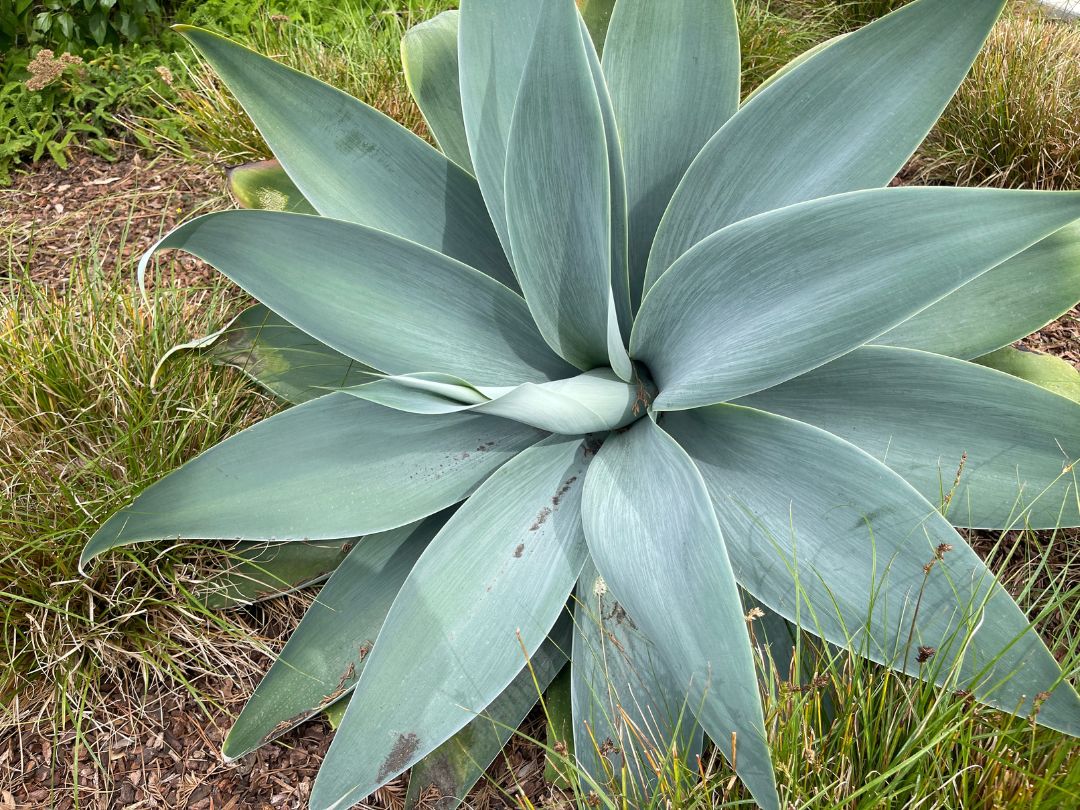
Agave Americana is a big blue succulent. There are also smaller striking blue agaves, like Agave ‘Blue Glow’ and Agave ‘Blue Flame’. I’m going to talk about Agave Attenuata ‘Nova’. I chose this particular agave because it should be easy to find, easy to grow and it looks great in the garden and in containers.
One of the many beauties of this agave is its big rosette, which can get to 4-5’ wide and tall. This large, blue rosette has soft, spineless leaves making it a harmless addition to your garden.
The common name for this blue agave is Blue Fox Tail Agave. Be careful when buying this plant: There’s another plant that goes by Blue Fox Tail Agave, which is the very similar Agave attenuata ‘Boutin Blue’ — and some nurseries identify them as the same plant.
The name Fox Tail comes from the long and drooping flower. This blue agave is monocarpic, which means the rosette dies after it flowers. Luckily, the plant readily self-propagates. Suckers grow from the mother plant as well as from seeds, cuttings, and bulbils. (I didn’t know what a bulbil is either – and I feel I know my way around garden botany).
5. Pilosocereus azureus
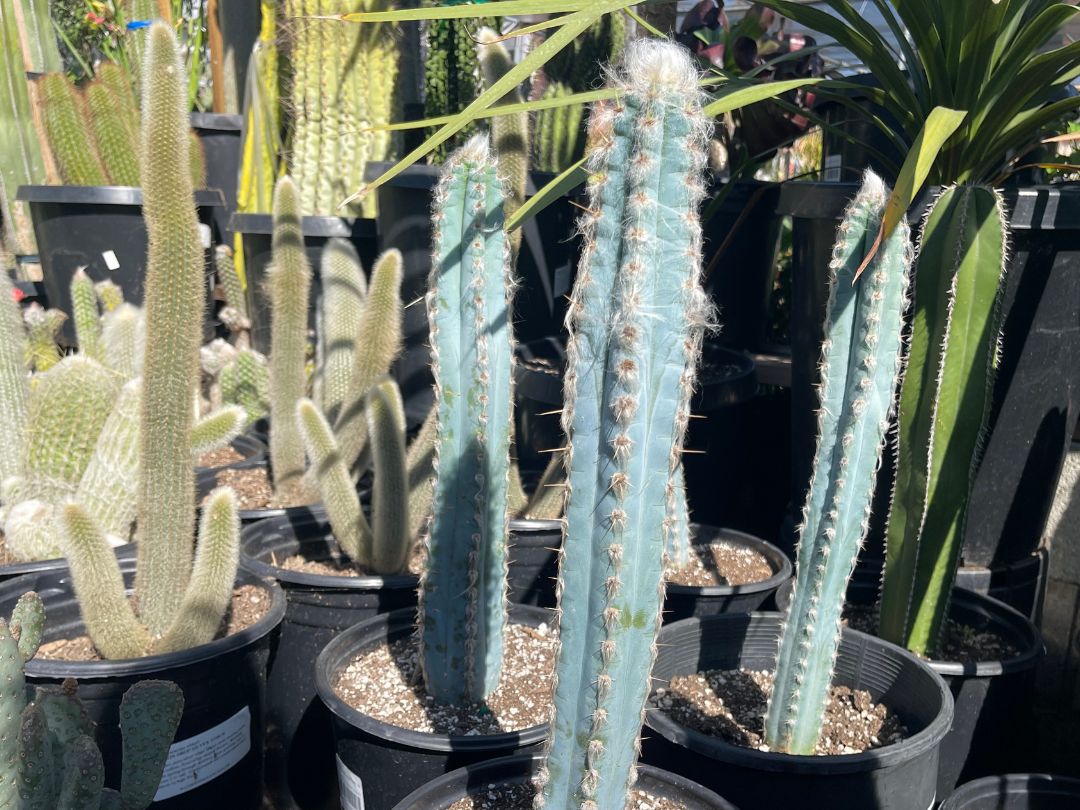
I’m now jumping over to the cacti category to discuss another blue succulent I love: Pilosocereus azureus. And what a stupendous specimen this is!
I had a client with a lovely dark green home, and we couldn’t pass up adding these blue succulents to her front porch in a very important location — flanking the front door. Blue Torch Cactus, the common name for this plant, is excellent in containers and even for growing indoors.
Pilosocereus azureus grows quickly to 12’. It needs full sun and very little water. Given enough sun, this plant gets even bluer as it ages. But without enough sunlight, Blue Torch Cactus will turn green. So give it lots of sun — because nobody wants a Blue Torch Cactus that’s not actually blue!
Now that you know about these five wonderful blue succulents, go on and add some cool blue to your garden! And if you’re on a succulents binge, check out these posts next:
We partner with select companies whose products and/or services we love. Some of the links on this page may be affiliate links. If you purchase an item using our affiliate link, we may receive a small commission (at no added cost to you). We appreciate your support.

